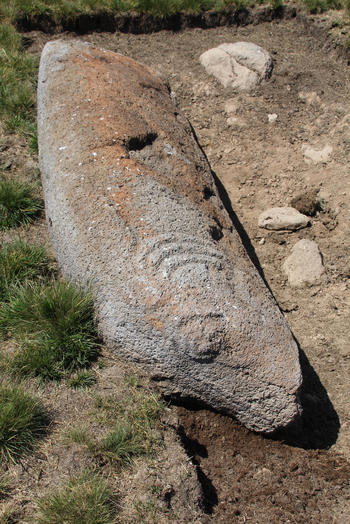Leaving No Dragon Stone Unturned
A team of archaeologists is investigating how the lives of semi-nomadic shepherds in the highlands of the South Caucasus interlink with “dragon stones” from the Copper Age
Jan 14, 2022
Archaeologists are studying artifacts and biofacts up to 7000 years old at a height of 2850 meters above sea level on Mount Aragats.
Image Credit: Arsen Bobokhyan
On the slopes of Mount Aragats, Armenia’s highest peak, shepherds have practiced their traditional way of life for generations. Referred to as “pastoralists” in social science, they migrate up and down the mountain with their families and their herds of sheep, cows, and horses, depending on the time of year.
During the summer months, when it gets so hot in the South Caucasus that the grass dries out and their animals can no longer graze, the shepherds pack up their tents and move to the highlands for several months to wait out the dry season. The population then migrates back down to the valley with their herds in the fall. This mobile way of life is known as “vertical transhumance” and has been observed for thousands of years.
Stelae, also known as vishap stones or dragon stones, usually depict fish or rams, or a combination of both. These types are only found in the mountains of the South Caucasus and eastern Turkey.
Image Credit: Pavol Hnila
Stelae Found in the Mountains
When the shepherds move to the highlands to allow their animals to graze, they encounter a very special type of stelae, known locally as vishaps or dragon stones, which are only found in the mountains of the South Caucasus and eastern Turkey. These stelae are several meters tall and depict either fish or rams, or sometimes a mixture of both. They are often located close to springs or streams, either standing vertically or lying horizontally.
Pavol Hnila is an archaeologist and postdoctoral researcher at the Institute of Ancient Near Eastern Studies at Freie Universität Berlin. He wants to study the stelae and find out why exactly they were erected in the mountains, whether the shepherds and their way of life have anything to do with the dragon stones, or whether hunters or even farmers braved the slopes to construct sites for rituals at different times of the year.
Hnila has been involved in a joint project between German, Italian, and Armenian archaeologists to excavate a site in the Armenian mountains since 2012. The archaeological site referred to as “Karmir Sar” is located 2850 meters above sea level, above the tree line. It is exceptional because this is where the highest number of dragon stones – twelve in total – has been found to date.
“Initially we didn’t know anything about them,” says Hnila. “Not the period they’re from, not why they were made, and nothing about their significance. We merely assumed that they had a clear cultic meaning, and we wanted to investigate all of these different aspects.”
A Plethora of Cultural Questions
The people in this region still pass down traditional sagas about water deities, aquatic creatures, and dragon-like spirits. But do these stories have anything to do with the stelae? Hnila and his colleagues Alessandra Gilibert and Arsen Bobokhyan determined that the stelae originate from the period between the end of the fifth and second millennium BCE, most probably from around 4000 BCE.
But many more questions remain: Who were the people who made and erected these stones? Where did they come from, and what became of their culture? “We’re still in the dark here – there are no written sources from this time, and we know nothing about their ethnic make-up,” says Hnila. “All we know is that they lived during the Copper Age, also known as the Chalcolithic.” He adds that this is also why we don’t know whether people who made the stelae lived a pastoral lifestyle; in other words, whether today’s shepherds are their descendants, or if they are the guardians of their way of life at the very least.
A new research project will address these questions, as well as attempt to determine how long vertical transhumance has been practiced. Hnila says that we know that this way of life has existed in the South Caucasus since the Middle Bronze Age, around 2000 BCE, but how long had it existed before then?
A further mystery surrounds the fact that there seem to have been periods during which the shepherds avoided the highlands, only to return later and resume migrating up and down the mountains. The team hopes to use pollen samples to test whether this may have had anything to do with climate change.
Answers Already on the Horizon
The problem lying at the heart of the excavation, of course, is that semi-nomadic cultures in which the people live in tents and pitch them at different sites depending on the time of year leave behind significantly fewer traces than an urban culture seeking to immortalize itself with monumental buildings and structures. These pastoralists have left behind a comparatively small footprint. Not only that, but the animal bones that could serve as irrefutable proof of shepherding in the highlands rapidly decompose in this environment and do not survive over time.
It is precisely this piece of evidence that could prove whether the people who erected the stelae were semi-nomadic shepherds. Hnila describes an extraordinary discovery of a large quantity of burned bones that were found right beside a stele and determined to be 6000 years old. The bones only survived because they were strongly calcified and had been exposed to much higher temperatures than a typical fire for roasting or grilling meat.
Were they burnt as sacrifices? Or were animal bones used instead of wood, since the people were far above the tree line and had no sticks to burn? Pavol Hnila is confident that he will be able to answer at least some of these questions by the time the research project is completed.
This article originally appeared in German on December 2, 2021, in the Tagesspiegel newspaper supplement published by Freie Universität.


